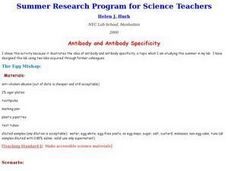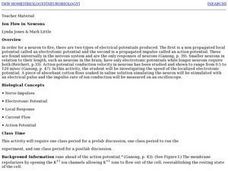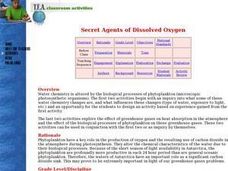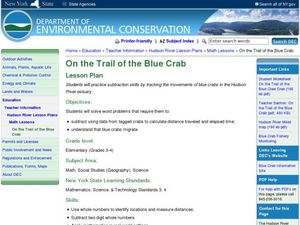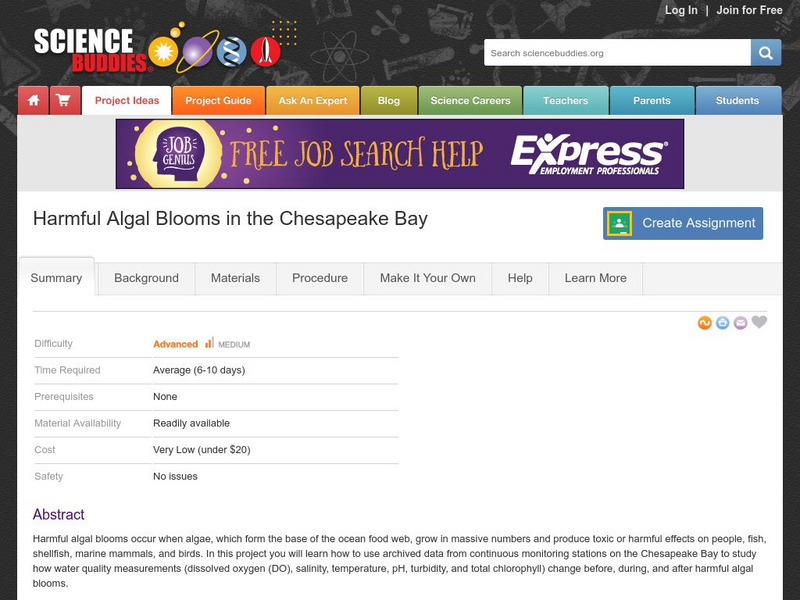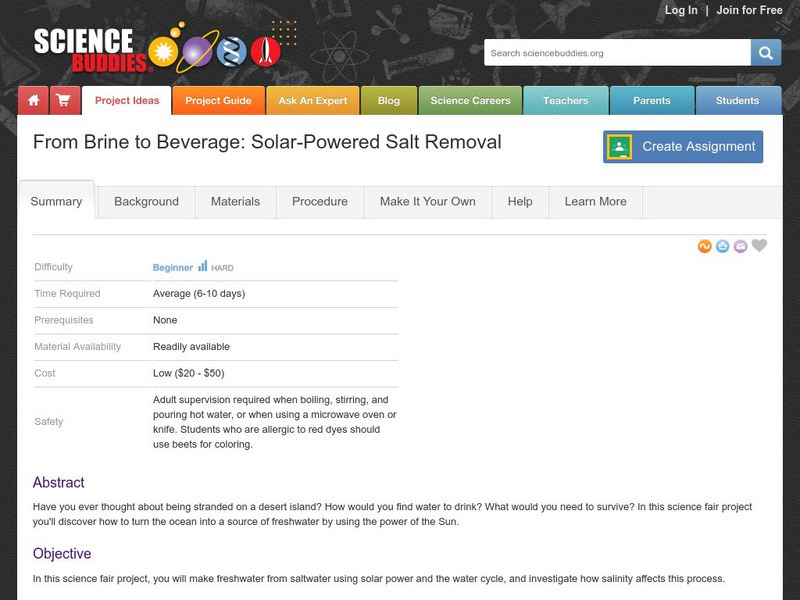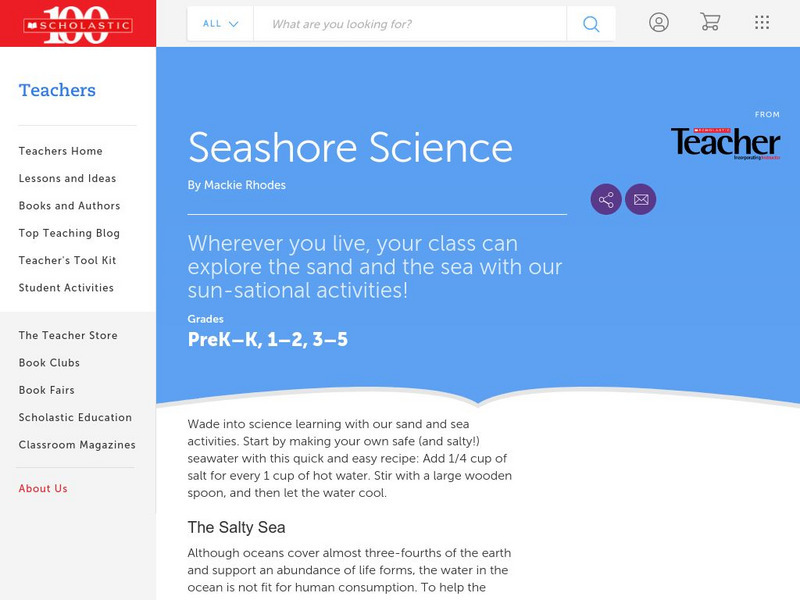Curated OER
Potato Fish Adaptations
Students examine fish adaptations. They identify types of adaptations, and create a 3-D model of an imaginary fish that demonstrates various adaptations using a potato and craft materials.
Curated OER
Ocean Microstructure Lesson Plan
Learners explore the microstructure of the ocean by analyzing graphs created by Dr. Mike Gregg of the University of Washington Applied Physics Laboratory during the EPIC 2001 research cruise on the Ronald H. Brown NOAA vessel.
Curated OER
Antibody and Antibody Specificity The Egg Mishap
Young scholars investigate a set of foods to find the presence of eggs after designing an experiment that will complete the test. They complete a test and discuss antibody-antigen specificity.
Curated OER
Sea Secrets
Students study the following: For centuries, people have been challenged by the mysteries that lie beneath the blue depths of our ocean planet. Very little was known about the ocean until late in the nineteenth century, although nearly...
Curated OER
Ion Flow in Neurons
Student perform an experiment in which they determine the velocity of ion flow in an electrotonic potential and compare it to the velocity of action potentials. They record and analyze their results.
Curated OER
Introduction To Brine Shrimp
Fourth graders engage in a variety of activities in order to find information about the brine shrimp. The lesson includes background information for the teacher to deliver instruction. They make observations of the shrimp in different...
Curated OER
Snow on Sea Ice
Students examine different samples of ice and predict the amount of snow that has fallen in a given year. Using a calculator, they graph the various thicknesses. They analyze the graphs to determine the relationship between the snow and...
Curated OER
Secret Agents of Dissolved Oxygen
Students determine the changes in different types of water in a sealed container over time. They investigate how to measure dissolved oxygen, temperature, and carbon dioxide with calculator or computer probe-ware. Students determine the...
Curated OER
Testing for Conductivity
Students test the conductivity of selected liquids and solids. They test the circuit by touching the two free ends of the wires together and add salt little by little recording the data after each addition. Finally, students predict...
Curated OER
On the Trail of the Blue Crab
Third graders read the article "Blue Claw," discuss crab migration, and look at a map of the Hudson River. They complete a worksheet where they must use subtraction to determine the distance migrating crabs travel.Web links, article, and...
Curated OER
Chesapeake Bay Population Studies
Learners determine how to use a quarter meter quadrant to find population density, relative density, frequency and how to calculate a diversity index while participating in a virtual field trip. They study how to establish a Correlation...
US Geological Survey
Usgs: Water Science for Schools Uses of Saline Water
This U.S. Geological Survey website explains a variety of uses for saline water. Pie graphs and bar graphs are used to illustrate the various uses. Click Home to access the site in Spanish.
Other
Bigelow Laboratory for Ocean Sciences: Salinity and Deep Ocean Currents
For this activity, students will investigate how temperature and currents affect the salinity of ocean water, making predictions after studying ocean maps. It is recommended that teachers do the experiment themselves before presenting it...
Science Buddies
Science Buddies: Harmful Algal Blooms in the Chesapeake Bay
Harmful algal blooms occur when algae, which form the base of the ocean food web, grow in massive numbers and produce toxic or harmful effects on people, fish, shellfish, marine mammals, and birds. In this project you will learn how to...
Science Buddies
Science Buddies: Can Water Float on Water?
Of course it can, you say: ice is water and ice floats. And you're right. But we're talking about water in the liquid phase Can liquid water float on water? The goal of this project is to investigate what happens to layers of water with...
Science Buddies
Science Buddies: From Brine to Beverage: Solar Powered Salt Removal
In this science fair project you'll discover how to turn the ocean into a source of freshwater by using the power of the Sun, and the water cycle. You will ultimately find just how salinity affects this process.
American Geosciences Institute
American Geosciences Institute: Earth Science Week: Sea and Ice Salinity
Students investigate the effects of salinity on the formation of sea ice, and whether salt water freezes more quickly or more slowly than fresh water.
US Geological Survey
U.s. Geological Survey: Saline Water
Information about saline water use in the United States.
Scholastic
Scholastic Instructor: Seashore Science
Come and learn with this incredible seashore science resource. The content includes fun facts, experiments, reproducible activities, resources and more.
CK-12 Foundation
Ck 12: Earth Science: Seawater Chemistry Study Guide
[Free Registration/Login may be required to access all resource tools.] This study guide summarizes key points about the composition of ocean water. Includes a few questions to check for understanding.
US Geological Survey
Usgs: Water Science for Schools Why Is the Ocean Salty?
This U.S. Geological Survey website offers one explanation of why the ocean is salty. Click Home to access the site in Spanish.
Science Struck
Science Struck: Density of Water at Room Temperature
Discusses how to calculate the density of water and how density varies depending on the temperature and the salinity. Presents a chart showing the difference in the density of non-saline water for temperatures between 0 and 100 degrees...
CK-12 Foundation
Ck 12: Earth Science: Seawater Chemistry
[Free Registration/Login may be required to access all resource tools.] Describes dissolved ions in seawater and their source.
CK-12 Foundation
Ck 12: Earth Science: Seawater Chemistry
[Free Registration/Login may be required to access all resource tools.] Describes the composition of seawater, including dissolved ions in seawater and their source.


